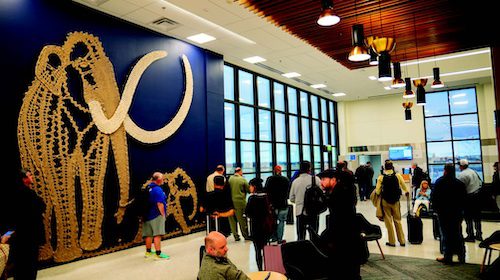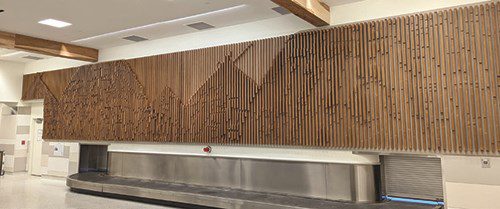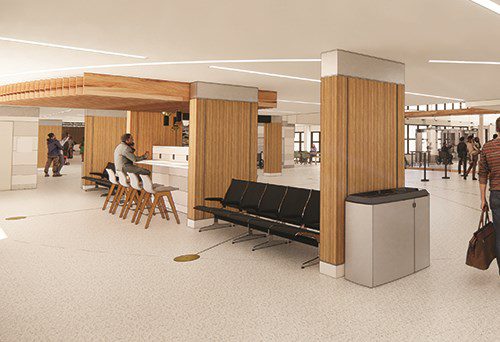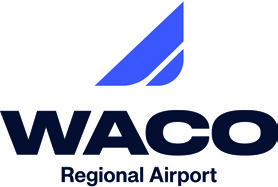Waco Regional Airport (ACT)—located smack dab between Austin-Bergstrom International (AUS) and Dallas Fort Worth International (DFW)—is making airport-wide investments to ensure that it will be able to continue meeting customer demand in central Texas.
Waco Regional Airport (ACT)—located smack dab between Austin-Bergstrom International (AUS) and Dallas Fort Worth International (DFW)—is making airport-wide investments to ensure that it will be able to continue meeting customer demand in central Texas.
 One key strategy was renovating its aging terminal. The airport’s recently completed $9.5 million project created a brighter, more modern facility with thoughtfully integrated public art that’s uniquely “Wacoesque.” Aviation Director Joel Martinez notes that the improvements provide ACT customers with an elevated experience and also help the centrally located airport showcase the city and community’s commitment to providing a top-notch facility to support air service development.
One key strategy was renovating its aging terminal. The airport’s recently completed $9.5 million project created a brighter, more modern facility with thoughtfully integrated public art that’s uniquely “Wacoesque.” Aviation Director Joel Martinez notes that the improvements provide ACT customers with an elevated experience and also help the centrally located airport showcase the city and community’s commitment to providing a top-notch facility to support air service development.
The airport’s two-gate terminal is about 40,000 square feet, and served roughly 180 passengers per day in 2019. While traffic declined significantly during the COVID pandemic, Martinez reports that ACT is seeing “pretty stable numbers” but is not currently growing due to the pilot and equipment shortages its regional carriers are experiencing. However, those same challenges provided the airport an opportunity to completely renovate its terminal without significant impact to daily operations.
|
Project: Terminal Renovation Location: Waco Regional Airport (in TX) Budget: $9.5 million Funding: Federal CARES Act grant; airport cash reserves Scope: 2 gates; 40,000 sq. ft. Construction: Aug. 2022-Dec. 2023 Architect: CaCo Architecture LLC General Contractor: Hensel Phelps Carpet: Milliken Exit Lane Breach Control System: Dormakaba Lighting: Texas Lighting Sliding Glass Wall: Dormakaba Tandem Seating: Herman Miller Terrazzo: American Terrazzo Ticketing Counters: Arconas Tile: Concept Surfaces Wood Portal at Security Checkpoint: Woodwright Wood Slat Ceilings: 9 Wood Wood Wall Panels: MAK Studio |
In 2020, the airport received $18.3 million via the Coronavirus Aid, Relief and Economic Security (CARES) Act, and management quickly identified necessary projects that previously lacked funding. Modernizing the terminal fit the bill perfectly.
Approximately $8.2 million of its remaining CARES Act funds were used to:
- refurbish passenger boarding bridges,
- replace the cab glass on the air traffic control tower,
- epave the overflow parking area and airport access drive,
- relocate a stormwater line, and
- recover salaries for airport personnel.
Looks Matter
In fall 2021, the airport contracted CaCo Architecture to develop plans for renovating its aging terminal. The firm had already begun designing improvements to the roof and heating, ventilation and cooling system, so it was an opportune time to renovate the terminal interior, too. The HVAC/roofing project and terminal renovation were combined into a single package, and Hensel Phelps was selected as the general contractor.
The last comprehensive terminal renovation at ACT occurred in 1999. Since then, there have been additions, but no major projects to update the existing facility. “This project addressed everything from the front door to the boarding bridges,” Martinez explains. “We went through the entire facility.”
“It was starting to really show its age, and the whole design was somewhat dated,” adds Roberto Diaz, AIA, associate principal with CaCo.
The project was not only about enhancing the facility for passengers, but also for airlines and other tenants. “We wanted to modernize and improve the aesthetic,” says Martinez. Specific changes included fresh carpeting and terrazzo flooring, new wall systems, replacing the old roof and converting lighting fixtures throughout the terminal to LEDs.
Restrooms were remodeled with updated and more efficient fixtures as well as wider stalls with longer partitions for more privacy and a contemporary look. The airport also added a family restroom.
Wireless connectivity has been improved throughout the terminal. And charging stations, workstations and in-seat charging outlets provide travelers with one of the most in-demand amenities. An emergency generator system, currently on backorder, is slated for installation by mid-March.
The process of redesigning the dated terminal while COVID-19 raged required flexibility. When in-person meetings were not an option, the project team used videoconferences. The remote technology proved especially helpful to secure input from the city council, airport advisory board, airlines and other tenants.
“Having those conversations helped us establish the expectations,” Martinez explains. “The collaborative effort by involving as many airport stakeholders and community stakeholders as possible at inception of the project really helped the finished project meet those expectations.”
 For CaCo, that process included benchmarking ACT with similarly sized airports around the country. Keeping in mind the airport’s goal of modernization, designers focused on ensuring a seamless transition from ACT to various hub airports. “We always kept in mind that the experience of a customer at Waco should be equal to the one that they have at DFW—the same level of amenities and quality of materials,” Diaz explains.
For CaCo, that process included benchmarking ACT with similarly sized airports around the country. Keeping in mind the airport’s goal of modernization, designers focused on ensuring a seamless transition from ACT to various hub airports. “We always kept in mind that the experience of a customer at Waco should be equal to the one that they have at DFW—the same level of amenities and quality of materials,” Diaz explains.
Phasing
Beginning in August 2022, five carefully coordinated phases shifted operations to just one gate while crews renovated the other. Temporary passenger screening facilities were set up in a former concessions area while the new TSA checkpoint was built. Once that was ready for passengers, work shifted to the second gate area.
At one point, temporary restrooms were needed. So for three months, the airport provided facilities in trailers parked outside the terminal. “We were thankful that our patrons were patient through that process, because that’s never fun,” Martinez remarks. However, the temporary restrooms and screening facilities, combined with an aggressive construction schedule, allowed ACT to complete its comprehensive terminal renovation in about 17 months.
Quiet hours with restricted decibel levels for contractors were established from 9:30 to 11:00 a.m. and again from 4:30 to 6:45 p.m., but flexed according to changing airline schedules. Dust barriers and temporary walls sequestered construction zones from passengers and airline operations areas.

Communicating with passengers, airlines and project partners on the front end of the project also helped minimize the impact of renovation work. “We did a lot of public service announcements locally and on social media, advising our passengers of the construction and letting them know the airport layout may be different and to anticipate needing a little additional time,” Martinez advises.
Coordination with TSA and American Airlines allowed the project to progress without reducing service or materially impacting passenger flow. Weekly coordination meetings with all parties ensured that issues were resolved quickly and reasonably, notes Mark Flewelling, project manager with Hensel Phelps.
 The terminal’s age added usual challenges associated with never knowing exactly what contractors might find behind the walls. To bring the entire terminal up to code, ACT extended the fire suppression system from its 2008 addition to the rest of the facility.
The terminal’s age added usual challenges associated with never knowing exactly what contractors might find behind the walls. To bring the entire terminal up to code, ACT extended the fire suppression system from its 2008 addition to the rest of the facility.
Manufacturing and supply chain disruptions associated with the COVID-19 pandemic contributed to a delay in the original 12-month project timeline. To help lessen the blow and turn over spaces as quickly as possible, planners and contractors shifted some work from one phase to another. “We still were able to keep the airport functioning, but also able to get ahead on the schedule in other areas,” Flewelling comments.
This is just one example of how close communication and flexibility from all partners benefited the entire project, he adds. “We all had a common goal, and the airport was very open to any suggestions to keep the schedule moving.”
Welcome to Waco
Early project planning sessions identified natural elements in the region that ultimately helped create a unique sense of place for the airport. Water, wood, greenery and local topography are all reflected in design elements throughout the newly renovated terminal. Natural wood beams in the ceiling, custom millwork and carpeting with flecks of blue are some of the visible ways natural elements and references were incorporated. New terrazzo flooring includes images of a Texas map, with Waco highlighted in the security vestibule.

Images in custom millwork pay tribute to the indigenous Native American Waco Tribe.
Large windows allow natural light to pour in, referencing the open Texas skies. The contours of wood millwork reflect local bodies of water and are a nod to the indigenous Native American Waco Tribe.
The airport also made an intentional effort to showcase public art. The city partnered with Creative Waco, a local nonprofit arts organization, to incorporate pieces that represent culturally and historically unique aspects of Waco. CaCo Architecture helped select the artwork and determine the best places to display it.
The four new pieces all radiate community pride: a canvas mural that depicts the city’s past, present and future; a suspended multi-media sculpture about local aviation; a digital collage of fabric patterns that communicate “Welcome to Waco” in 50+ languages; and a giant mounted sculpture of a mammoth that roamed the area during the Ice Age.
The artwork combines with other enhancements to create a brighter, more modern and streamlined terminal to welcome passengers to Waco, Martinez concludes.


 facts&figures
facts&figures

